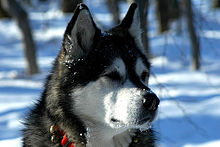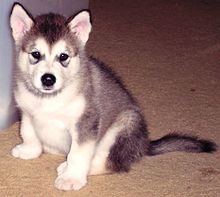Alaskan Malamute
The neutrality of this article is disputed. |
| Alaskan Malamute | |||||||||||||||||
|---|---|---|---|---|---|---|---|---|---|---|---|---|---|---|---|---|---|
 Alaskan Malamute | |||||||||||||||||
| Common nicknames | Mal | ||||||||||||||||
| Origin | United States (Alaska) | ||||||||||||||||
| |||||||||||||||||
| |||||||||||||||||
| Dog (domestic dog) | |||||||||||||||||
The Alaskan Malamute is a large breed of domestic dog (Canis lupus familiaris) originally bred for use as an Alaskan sled dog and is often mistaken for a Siberian Husky.
Description
Appearance
The AKC breed standard calls for a natural range of size, with a desired freighting weight of 75 to 85 pounds (34–39 kg) and a height of 23 to 26 inches (58–64 cm).Some Mals have been known to reach 32 inches (810 mm). Heavier individuals (90lbs) and dogs smaller than 75 pounds are common. Some Mals have been known to tip the scales at over 160 lb (73 kg). There is often a marked size difference between males and females. Weights upwards of 95 pounds are occasionally seen, but this is uncommon and such dogs are produced primarily by breeders who market a 'large Malamute.' These large sizes are not in accordance with the breed's history or show standards. The coat is a dense double northern dog coat, somewhat harsher than that of the Siberian Husky. The usual colors are various shades of gray and white, sable and white, black and white, red and white, or pure white. Eyes are almond-shaped and are always various shades of brown (from dark to light, honey or hazel brown); blue eyes are an indication of mixed breeding and will disqualify the dog in shows. The physical build of the Malamute is compact with heavy bone. In this context 'compact' means that their height to length ratio is slightly longer than tall, unlike dogs like Great Danes which are longer and lankier in their ratios.

According to the American Kennel Club, the primary criterion for judging the Malamute in a show is its function to pull heavy freight as a sled dog; everything else is secondary. As many an owner has found out, the pulling power of a Malamute is tremendous.
The malamute has a plume like tail that is well furred and hangs just over the back like a "plume". This is the standard written in the breed book. Corkscrew tails can now be seen but is not the breed description . A corkscrew tail is what you would see in the Akita. The malamutes' tails, well-furred, aid in keeping them warm when they curl up in the snow . They wrap the tail around their nose and face which helps protect them against harsh weather like blowing snow.
Though superficially similar to wolves, there are several physical differences. When compared to a similarly sized wolf, the malamute's head is not as wide, shorter, and generally smaller. Their necks are generally the same size, though the malamute is bigger in the chest by a few inches. The malamute stands two inches shorter, is three inches (76 mm) shorter in the leg, and eight inches (203 mm) shorter in the body. The wolf's tail is longer and has no tendency to curl over its back as the malamute's can. The wolf's track is nearly twice as large as that of the Malamute.[1]

Temperament
While a few Malamutes are still in use as sled dogs for personal travel, hauling freight, or helping move heavy objects, some are used for the recreational pursuit of sledding also known as mushing, also skijoring, bikejoring, and canicross. However, most Malamutes today are kept as family pets or show dogs. Although in 1994 Nancy Russell ran a team of Malamutes in the Iditarod Trail Sled Dog Race, completing 600 miles (970 km) of the roughly 1,150-mile (1,850 km) race before pulling her team, the Malamute is generally slower in long-distance dogsled racing against smaller and faster breeds and their working usefulness is limited to freighting or traveling over long distances at a far slower rate than that required for racing. They can also help move heavy objects over shorter distances.
The Malamute is one of the most "unaltered" of breeds, retaining its original form and function. If a dog owner cannot cope with a dog that will not comply with the owner's every command, a more compliant breed should be selected. This dog has a long genetic foundation of living in the wilderness with man surrounded by other domesticated animals of approximately the same size.
There is reason to believe that Alaskan Malamutes cope poorly with smaller animals, including canines; however, this has been difficult to document in detail beyond observational data. It is difficult to pinpoint why many Malamute owners have observed this behavior with smaller animals, though some might speculate this is due to the Malamute's uniquely divergent ancestry, at one point cross-breeding with wolves.[2] So while Malamutes are, as a general rule, particularly amiable around humans and children and in some instances friendly with smaller dogs, it is probably a good rule of thumb to be mindful of your Malamute around smaller animals until you have become acquainted with its behavior.
Generally speaking, time and experience will show if a dog can be left unwatched with other household pets. In this respect, it is also important to understand that just because your Malamute is comfortable with your other pets, this does not mean it will be comfortable around other animals it encounters. And while Malamutes aren't normally thought of as territorial dogs, they may react unfavorably to unfamiliar house guests. Like many canines, Malamutes may become aggressive around other unfamiliar dogs, especially if they are not neutered or spayed.[3] This is important to note due to their powerful, deep chest and large head.[4] Male dogs are of particular note, as they are generally the more aggressive sex, due to factors like testosterone acting on the brain, which is one of the major reasons veterinarians recommend neutering as a puppy.[3] Overall, however, Malamutes are quite fond of people, a well known trait that makes them particularly sought-after family dogs. Malamutes are thought to be clumsy, but are nimble around furniture and smaller items, making them ideal house dogs. However, they prefer to be outdoors in winter to enjoy the snow. If they are year-round outdoor dogs, letting them play in a baby pool filled with cold water in summer keeps them cool. They will stand in the baby pool at times, seemingly doing nothing at all. However, they absorb much of the coolness of the water through their paws.
The majority of Malamutes are also fairly quiet dogs, seldom barking like most other dog breeds. When it does vocalize, more often than not they tend to "talk" by vocalizing a "woo woo" sound (the characteristic vocalizations of Chewbacca in the Star Wars films are based upon a Malamute named Indiana once owned by George Lucas).[5] They may howl like wolves or coyotes, and for the same reasons. When they howl, the howl is difficult, if not impossible, to distinguish from the wolf.
Health
Mortality
There is only one known health survey of Alaskan Malamutes, a 2004 UK Kennel Club survey with a small sample size of 14 dogs.[6] The median lifespan of 10.7 years measured in that survey is very typical of a breed their size.[7]. The major cause of death was cancer (36%).[8]
Morbidity
The most commonly reported health problems of Alaskan Malamutes in the 2004 UK Kennel Club survey (based on a sample size of 64 dogs) were musculoskeletal (hip dysplasia), and Hereditary Cataract.
Malamutes in the US have been known to suffer other problems (see below)
Other health issues in Malamutes include inherited polyneuropathy, chondrodysplasia, and eye problems (particularly cataract and progressive retinal atrophy).[9]
Climate and Malamutes
While Malamutes have been successfully raised in places such as Arizona, their dense coats generally make them unsuited for hot climates. When the weather gets hot, like any other breed of dog, the malamute needs plenty of water and shade. They will grow a winter coat and subsequently, come spring, shed it again.
History
The Malamute is a descendant of dogs of the Mahlemuits tribe of upper western Alaska. These dogs had a prominent role with their human companions – working, hunting, and living alongside them. The interdependent relationship between the Mahlemut and their dogs fostered prosperity among both and enabled them to flourish in the inhospitable land above the Arctic Circle.
For a brief period during the Klondike Gold Rush of 1896, the Malamute and other sled dogs became extremely valuable to recently landed prospectors and settlers, and were frequently crossbred with imported breeds. This was often an attempt to improve the type, or to make up for how few true Malamutes were up for sale. This seems to have had no long standing effect on the modern Malamute, and recent DNA analysis shows that Malamutes are one of the oldest breeds of dog, genetically distinct from other dog breeds.[10]
The Malamute dog has had a distinguished history; aiding Admiral Richard Byrd to the South Pole, and the miners who came to Alaska during the Gold Rush of 1896. This dog was never destined to be a racing sled dog; instead, it was used for heavy freighting, pulling hundreds (maybe thousands) of pounds of supplies to villages and camps in groups of at least 4 dogs for heavy loads.
The Alaskan Malamute is a member of the Spitz group of dogs, traced back 2,000 to 3,000 years ago to the Mahlemuits tribe of Alaska.
"In shape, the Paleolithic dogs most resemble the Siberian husky, but in size, however, they were somewhat larger, probably comparable to large shepherd dogs," stated Germonpré, a paleontologist at the Royal Belgian Institute of Natural Sciences. This description of recently found 30000 years old dog remains fits the Alaskan Malamute very closely. Though not scientifically confirmed, could the Alaskan Malamute be the closest living relative to the "First Dog"?[11]
See also
- Siberian Husky
- Canadian Eskimo Dog
- Eight Below (Film, 2006)
Footnotes
- ^ Lopez, Barry (1978). Of wolves and men. p. 320. ISBN 0743249364.
- ^ The New York Times > Science > Collie or Pug? Study Finds the Genetic Code
- ^ a b Neutering Male Dogs
- ^ American Kennel Club - Alaskan Malamute
- ^ http://news.bbc.co.uk/2/hi/entertainment/6679425.stm BBC
- ^ http://users.pullman.com/lostriver/breeddata.htm Dog Longevity Web Site, Breed Data page. Compiled by K. M. Cassidy. Retrieved July 8, 2007
- ^ http://users.pullman.com/lostriver/weight_and_lifespan.htm Dog Longevity Web Site, Weight and Longevity page. Compiled by K. M. Cassidy. Retrieved July 5, 2007
- ^ http://www.thekennelclub.org.uk/item/570 Kennel Club/British Small Animal Veterinary Association Scientific Committee. 2004. Purebred Dog Health Survey. Retrieved July 5, 2007
- ^ http://www.alaskanmalamute.org/Health/health.asp Alaskan Malamute Club of America Health Committee Retrieved July 10, 2007
- ^ NYTimes
- ^ MSNBC
References
External links
- Alaskan Malamute Club of America
- Alaskan Malamute Club of the UK
- The Alaskan Malamute Club of Canada
- Alaskan Malamute Club of NSW (Australia)
- Database of Malamutes
- Photos of Malamutes
This article needs additional citations for verification. (September 2007) |
